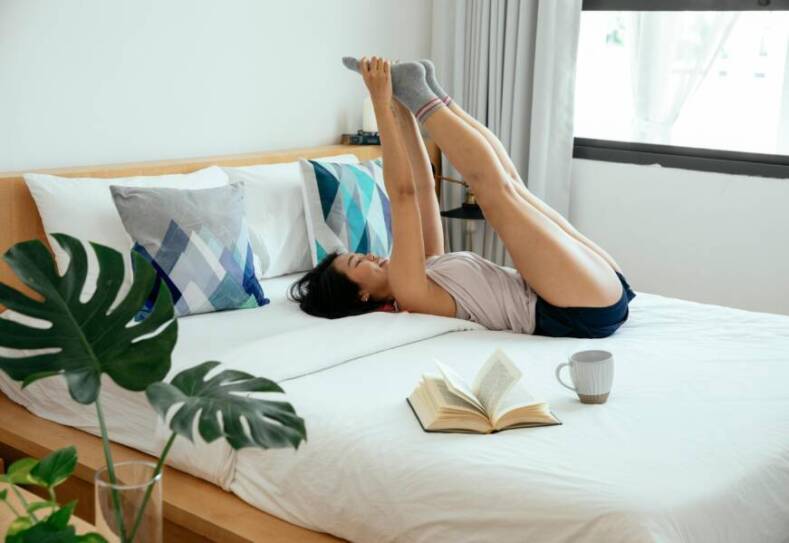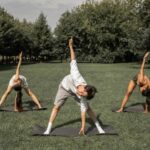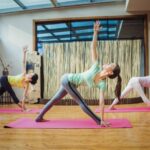Engaging in stretching exercises has been widely regarded as a beneficial activity to enhance physical well-being, promoting better sleep quality and relaxation. When performed before bed, stretching can serve as a powerful tool for stress relief, helping to calm the mind and prepare the body for rest. It allows for a gentle release of tension accumulated throughout the day, making it easier to unwind and transition into a state conducive to sleep.
In contrast, incorporating stretching into morning routines can energize the body and improve movement for the day ahead. Morning stretches help to increase blood flow, awaken the muscles, and improve flexibility, potentially leading to increased alertness and a better start to the day. It’s a moment to connect with one’s body after hours of inactivity, setting a positive tone for the ensuing activities.
Both nighttime and morning stretching routines serve distinct purposes that support a healthier lifestyle, yet they share common benefits including the promotion of flexibility, aiding in relaxation, and potentially mitigating stress. The choice of when to stretch may depend on individual needs and the specific outcomes one aims to achieve, whether it’s preparing for a restful night’s sleep or invigorating the body in anticipation of the day’s demands.
Benefits of Stretching
Regular stretching can greatly contribute to one’s overall health by improving flexibility, enhancing mobility, and reducing muscle tension. Specific to time of day, stretching in the morning can invigorate the body, while evening routines may promote restful sleep.
Improves Sleep Quality
Stretching before bed can lead to better sleep quality. By performing gentle stretches, one can relieve the tension accumulated in muscles throughout the day. For instance, stretching the neck, shoulders, and lower back can ease the stiffness that often contributes to discomfort and restlessness. Improved blood circulation from these activities can also help in calming the body and preparing it for sleep.
Enhances Flexibility and Mobility
Incorporating stretching into daily routines has been shown to significantly enhance flexibility and mobility. Stretching can equalize the muscle length around joints, which contributes to a more free and efficient movement. Over time, this can lead to improved performance in physical activities and a reduction in the risk of injuries.
Reduces Stress and Tension
Stretching acts as a powerful tool to reduce stress and tension in the body. It helps to release endorphins, providing a sense of calm and well-being. By focusing on key areas like the neck and shoulders, individuals can reduce the buildup of stress that often leads to headaches and muscle tightness. Regular stretching can serve as a moment of mindfulness, offering mental relief alongside physical benefits.
Stretching Before Bed
Incorporating stretching into a nightly routine can lead to better sleep quality and enhanced relaxation. It can also target common areas of tension like the lower back and hips, offering notable stress relief.
Creating a Relaxing Routine
To create a relaxing stretching routine before bed, one should choose a quiet space and possibly dim the lights to signal to the body that it’s time to wind down. Gentle, rhythmic stretching can aid the natural decline in body temperature and heart rate, aligning with the body’s circadian rhythms. Routine resistance exercises should be avoided as they may increase heart rate and energy levels, which isn’t conducive to sleep.
Suitable Stretches for the Evening
A focus on gentle stretches is key in the evening to prepare the body for rest:
- Lower Back: Child’s Pose
- Kneel on the floor, sit back on your heels, and then lean forward, stretching your arms out in front and placing your head down.
- Hips: Butterfly Stretch
- Sit with the soles of your feet together and gently press your knees down with your elbows.
- Hamstrings: Seated Forward Bend
- Extend your legs in front, hinge at the hips and reach your hands towards your toes.
- Quads: Standing Quad Stretch
- Stand on one leg, hold the other foot with your hand, and gently pull towards your buttocks.
These stretches can be held for 20-30 seconds, promoting calm and potentially reducing stress. Engaging in such a routine regularly may improve sleep quality over time.
Morning Stretching
Morning stretches are a vital component for energizing one’s day and awakening the body. They promote mobility and help transition muscles from a state of rest to activity, setting a positive tone for the day ahead.
Energizing Your Day
Engaging in a morning stretching routine can lead to increased energy levels. Dynamic stretching is particularly effective in the morning as it involves movement and can help raise body temperature and improve blood flow. These stretches not only prepare the body for the day’s tasks but also help to shake off any stiffness from sleep.
- Shoulder Rolls: A simple movement to ease tension and improve shoulder mobility.
- Arm Circles: Gradually increase the radius to warm up the shoulder joints.
Dynamic Stretches to Awaken Muscles
Dynamic stretches are ideal for stimulating muscles and promoting an awakening effect throughout the body. They involve active movements that allow muscles to stretch and joints to move through their full range of motion.
- Lunges with a Twist: Enhances coordination and activates the muscles of the legs, hips, and core.
- Leg Swings: Front-to-back and side-to-side leg swings prepare the lower body for movement, targeting hip flexibility.
Incorporate these dynamic stretches into a morning routine to effectively transition the body from rest to a state of readiness for the day’s demands.
Specific Stretches and Their Benefits
Incorporating stretches into a nighttime or morning routine can significantly benefit the body’s flexibility, mobility, and relaxation. This section details specific stretches targeting various muscle groups to aid in better sleep and reduced tension.
Hamstring and Lower Body Focus
For the hamstrings, Seated Forward Fold is an effective stretch. Sitting on the ground, extend the legs forward and hinge from the hips to reach towards the toes. This stretch can alleviate tightness in the hamstrings, often exacerbated by prolonged sitting at a desk or driving a car.
- Quadriceps Stretch: Standing on one leg, pull the other foot towards the glutes, keeping the knees together and the hips forward. This stretch engages the front of the thighs and is beneficial for those who engage in activities that put pressure on the knees and thighs.
Upper Body Stretches
- Shoulder Stretch: Place one arm across the body and use the other arm to pull it closer, stretching the shoulder. This move is great for releasing tension after carrying a heavy load or sitting for long periods.
To address the neck and trapezius muscles, a simple Neck Stretch involves tilting the head to one side to stretch the side of the neck, and rotating the neck gently helps in relieving tension that accumulates from daily activities like looking at a computer screen or sleeping in an awkward position.
Deep Muscle Work
- Spinal Twist: Lying on the back, bring one knee across the opposite side of the body while keeping the shoulders flat on the ground. This stretch engages the spine, glutes, and hips, promoting relaxation and flexibility in the lower back.
For deeper muscle relaxation, Chest Stretch effectively opens up the chest and upper back. Stand in a doorway and place the forearms on the door frame, then gently step forward until a stretch is felt in the chest and shoulders. This counteracts the forward hunch that can develop from sitting at a desk or driving.
By spending a few minutes on these stretches, one can help to ensure that the body’s muscles are loose and relaxed, potentially leading to a better quality of sleep and a more comfortable start to the day.
Preventing Injury and Pain
Incorporating a specific set of stretches into daily routines can play a crucial role in preventing injury and managing pain, particularly in areas such as the back, neck, and joints.
Incorporating Stretching into Daily Routines
Individuals aiming to reduce discomfort and prevent injury should embrace a regular stretching regimen. Stretching can enhance recovery, alleviate tension, and maintain mobility across various body parts, including the back, shoulder, neck, joints, ankles, and wrists. To illustrate:
- Morning: Stretching in the morning can set a positive tone for the day, promoting spinal mobility and preparing the joints for daily activities.
- Before Bed: Nightly stretching can be especially beneficial in alleviating back pain and ensuring muscles are relaxed, aiding in a restful sleep.
Posture and Alignment
Maintaining good posture and proper body alignment is essential in the prevention of musculoskeletal pain and injury. Stretches that focus on the spine, shoulders, and hips are pivotal. For example:
- Spinal Alignment: Practices that include stretching the spine can improve postural alignment and reduce the risk of lower back pain.
- Shoulder and Neck Tension: Regular stretching of the shoulder and neck region helps in alleviating built-up tension, preventing potential strain or injury.
Mindfulness and Stretching
Incorporating mindfulness into stretching routines, like in yoga and meditative practices, can enhance relaxation and stress reduction. The focus on breathing techniques during these exercises serves to deepen the sense of calm and present-moment awareness.
Yoga and Meditative Practices
Yoga is a discipline that combines physical poses with meditative focus to foster a sense of calm and mindfulness. Through gentle stretching and holding yoga poses, such as Child’s Pose or Downward Facing Dog, individuals can cultivate relaxation which may alleviate stress and anxiety. The meditative aspect of yoga encourages a focus on the present moment, allowing for a release of tension and mental clutter.
- Yoga Poses for Mindfulness:
- Child’s Pose: Encourages release and relaxation of the back muscles.
- Downward Facing Dog: Stretches the entire body and helps focus the mind.
In yoga, it is not just the holding of the poses that promotes mindfulness; it is also the transitions between these poses. Acknowleding every movement allows for a meditative and introspective experience, deepening the relationship between mind and body.
Breathing Techniques
Effective breathing techniques are integral to both physical and mental relaxation during stretching routines. Deep breathing, or diaphragmatic breathing, is particularly beneficial as it promotes a full oxygen exchange and can decrease the heart rate, which aids in reducing stress and anxiety.
- Key Breathing Techniques:
- Diaphragmatic Breathing: Inhale deeply through the nose, allowing the abdomen to rise, then exhale slowly and fully.
- Counted Breaths: Inhale for a count of four, hold the breath for a count of four, exhale for four, and wait for four before the next breath.
By focusing on their breath, individuals can enhance their mindfulness practice during stretching. This focus helps to anchor them in the present moment, fostering a tranquil space which can prepare them for rest when performed before bedtime or awaken the mind when practiced in the morning.
Daily Habits and Environmental Factors
Maintaining good health and optimizing performance in daily activities requires attention to both established routines and the settings in which individuals spend their time. Ergonomics at the workplace and proper sleep environment at home are pivotal factors that influence overall well-being.
Ergonomics at Work and Home
Desk Setup:
- Chair: An ergonomic chair that supports the spine’s natural curve can reduce back pain and improve posture.
- Desk: The desk height should allow forearms to rest comfortably and the monitor at eye level to avoid neck strain.
Car Ergonomics:
- Seat Position: Adjusting the car seat to support the lumbar region and align the steering wheel to reduce shoulder strain can help maintain posture during long drives.
Older Adults: Ergonomic adaptations are particularly beneficial for older adults to decrease the risk of falls and improve comfort.
Quality Sleep Environment
Mattress: A supportive mattress is crucial for spinal alignment and can significantly affect sleep quality and duration, impacting one’s mood and performance.
Evening Routine:
- Stress Relief: Engaging in stress-relieving activities, such as reading or taking a warm bath, helps prepare the body for restful sleep.
- Technology: Limiting exposure to screens and bright lights in the evening aids the natural sleep-wake cycle.
Sleep Environment:
- Quiet: A noise-free sleep environment is essential for uninterrupted sleep.
- Darkness: A dark room signals the brain that it’s time for sleep, enhancing sleep quality.
Daily Habits: Integrating stretching into an evening routine may help alleviate tension, promote relaxation, and contribute to better quality sleep.
Stretching Variations for Different Needs
Individuals may need to modify their stretching routines based on personal factors such as age, mobility limitations, and physical condition. The following subsections offer guidelines for adapting stretching techniques to cater to these varying needs.
Age-Related Modifications
For older adults, engaging in gentle stretching can improve muscle elasticity and joint flexibility. Stretches like the legs up the wall can help relieve tension without strain. A side stretch, where one reaches overhead while sitting or standing, can enhance lateral flexibility. A daily routine might include:
- Bear Hug: Wrap arms around the torso, as if giving oneself a hug, to release the upper back.
- Butterfly Stretch: Sitting down, press the bottoms of the feet together and gently push knees down for inner thigh and hip flexibility.
Additionally, incorporating movements from tai chi can provide a gentle yet effective way to maintain flexibility and balance.
Adaptive Techniques for Limited Mobility
Individuals with limited mobility or those in injury recovery may require adaptive techniques to safely stretch and improve flexibility. Using props or modifying the position can provide support and ensure proper alignment. Some variations include:
- Seated Lunge: Instead of a traditional lunge, perform this exercise while seated in a chair to reduce joint strain.
- Assisted Side Stretch: Use a towel or a strap to aid in stretching if one cannot comfortably reach overhead.
- Legs up the Wall: Perform with a cushion under the hip for lower back support if necessary.
- Butterfly: If the full stretch is uncomfortable, place pillows under each knee for support.
Each variation should be tailored to the individual’s current capabilities to promote safe and effective stretching while preventing injury.








